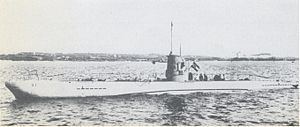Name U-1 Laid down 11 February 1935 Construction started 11 February 1935 Length 41 m Beam 4.08 m | Ordered 2 February 1935 Yard number 236 Commissioned 29 June 1935 Launched 15 June 1935 Draft 3.83 m | |
 | ||
German submarine U-1 was the first U-boat (or submarine) built for Nazi Germany's Kriegsmarine following Adolf Hitler's abrogation of the terms of the Treaty of Versailles in 1935, which banned Germany possessing a submarine force.
Contents
A Type IIA U-boat, she was built at the Deutsche Werke shipyards in Kiel, yard number 236. Her keel being laid on 11 February 1935 amid celebration. She was completed on 29 June 1935 after a very rapid construction, and was manned by crews trained in the Netherlands.
Design
German Type II submarines were based on the Finnish submarine Vesikko. U-1 had a displacement of 254 tonnes (250 long tons) when at the surface and 303 tonnes (298 long tons) while submerged. Officially, the standard tonnage was 250 long tons (250 t), however. The U-boat had a total length of 40.90 m (134 ft 2 in), a pressure hull length of 27.80 m (91 ft 2 in), a beam of 4.08 m (13 ft 5 in), a height of 8.60 m (28 ft 3 in), and a draught of 3.83 m (12 ft 7 in). The submarine was powered by two MWM RS 127 S four-stroke, six-cylinder diesel engines of 700 metric horsepower (510 kW; 690 shp) for cruising, two Siemens-Schuckert PG VV 322/36 double-acting electric motors producing a total of 360 metric horsepower (260 kW; 360 shp) for use while submerged. She had two shafts and two 0.85 m (3 ft) propellers. The boat was capable of operating at depths of up to 80–150 metres (260–490 ft).
The submarine had a maximum surface speed of 13 knots (24 km/h; 15 mph) and a maximum submerged speed of 6.9 knots (12.8 km/h; 7.9 mph). When submerged, the boat could operate for 35 nautical miles (65 km; 40 mi) at 4 knots (7.4 km/h; 4.6 mph); when surfaced, she could travel 1,600 nautical miles (3,000 km; 1,800 mi) at 8 knots (15 km/h; 9.2 mph). U-1 was fitted with three 53.3 cm (21 in) torpedo tubes at the bow, five torpedoes or up to twelve Type A torpedo mines, and a 2 cm (0.79 in) anti-aircraft gun. The boat had a complement of 25.
Service history
Her pre-war service was unremarkable, but she did gain a reputation as a poor ship. Her rapid construction, combined with the inadequacy of the technology which was used to create her, made her uncomfortable, leaky and slow. When war came, there were already plans to shelve her and her immediate sister boats for use as training boats only.
Despite this however, owing to a shortage of available units she sailed on 29 March 1940 against British shipping operating off Norway, close to the limit of her effective operating range. She failed to find a target, but was sent out again on 4 April, in preparation for Operation Weserübung (the invasion of Norway).
Fate
U-1 sent a brief radio signal on 6 April, giving her position, before she disappeared. The cause of her loss is unknown, but she was scheduled to sail through a minefield laid unknown to the Germans by the British submarine Narwhal that same day. U-1 may have also been sunk by the British submarine Porpoise, which reported launching a torpedo at an unidentified enemy submarine (subsequently thought to be U-3), on 16 April following the invasion.
She was the first of over 1,000 U-boats to serve during the Battle of the Atlantic, and one of over 700 to be lost at sea.
